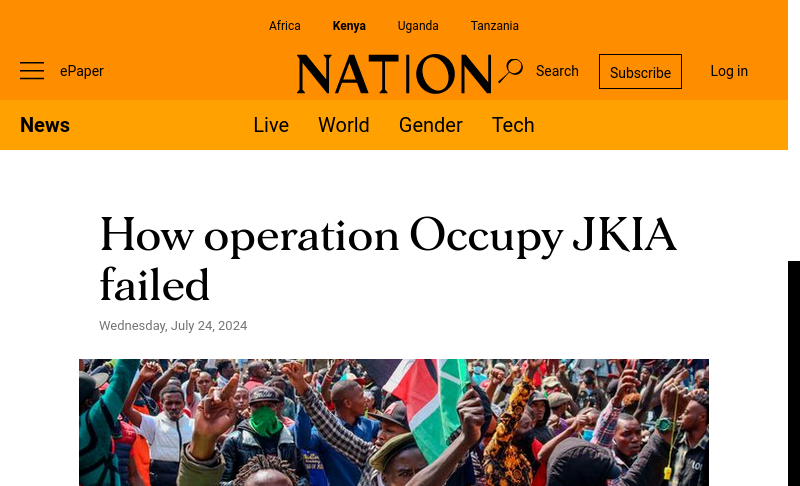you have the possibility to publish an article related to the theme of this page, and / or to this region:
Kenya - -An information and promotions platform.
Links the content with your website for free.

Kenya - Web content about JKIA news

Your premium access has ended, but the best of Nation.
Africa is still within reach.
Renew now to unlock exclusive stories and in-depth features.
The much-hyped plan by Generation Z to occupy Jomo Kenyatta International Airport (JKIA) was foiled as police successfully thwarted any attempt by the protesters to gain access to the vital transport facility.
From Monday night, scores of police officers were deployed at strategic points along the main roads leading to the busy airport, which handles hundreds of flights a day.
These included the main entrance to JKIA, just off Mombasa Road, where at least 15 armed police stood guard with their guns ready to respond to any form of intrusion.
Plainclothes officers also walked the perimeter of the sprawling airfield, keeping a close eye on what was going on inside and outside.
Two water cannons were also on standby at the far left of the entrance, with security guards preventing anyone from entering the airport unless they showed their passports and/or flight tickets.
By 11 am it was business as usual at the airport, although the number of vehicles on the road leading to the terminals was unusually low.
This was largely because travelers had arrived at the airport much earlier, following instructions from the Kenya Airports Authority, and some were even reported to have slept at the airport.
Just a few hundred meters from the main entrance to the airport, a huge lorry full of police officers was strategically placed at the JKIA Expressway Terminal, giving the uniformed officers a vantage point from which to carefully analyze the activities taking place around the airport.
Less than a kilometer from the airport, several police officers were deployed at the junction of Mombasa Road and Airport North Road to prevent any protesters from accessing the Mombasa-bound highway and heading for the protected airfield.
There was also a large contingent of police at the other entrance to the airport, off Outering Road.
There were at least two water cannons, three lorries, and a heavy-duty lorry.
These officers played a crucial role in pushing back hundreds of stone-throwing protesters who were attempting to enter the airport via the Outering Road.
For hours they were engaged in fierce running battles, with more and more officers being called in to reinforce them and to ensure that the agitated crowd did not get through the airport's barbed wire fence.
Further along Airport North Road, more police were deployed at the point where the airport perimeter wall begins, with even more officers patrolling the entire length of the airfield on foot.
This was also the case at the main Kenya Airways entrance, where more armed police were stationed alongside private guards.
At Stage 75, which is a major artery connecting people from as far afield as Kayole, Tassia, and B Centre to the North Airport Road, the police were patrolling in their Land Cruisers and would not allow several people to congregate at one point.
They asked them to return home.
There was some chaos at Imara Daima, where hundreds of youths flooded Mombasa Road carrying banners and chanting anti-government songs.
Police responded swiftly, firing tear gas and engaging in running battles, effectively pushing the protesters back into the estate.
It is the clashes along the Outering Road, particularly at Pipeline, that took center stage on Tuesday.
For nearly five hours, uniformed officers fought off several attempts by protesters to overrun their barricade and enter the airport through the entrance at the end of Outering Road.
Tear gas and smoke from burnt tires forced locals, journalists, and police alike to cough and shed tears, while huge stones, metal, and pieces of wood were lined up on the road to cripple traffic in the area.
The officers could not hide their frustration as dozens of youths regrouped, putting back all the debris on the road moments after they had cleared it to allow reinforcements to enter the hotspot areas.
So serious was the situation that at one point four vehicles, a lorry, and three military pickups, carrying at least 40 soldiers, joined the police on the Outering road.
All the soldiers were armed with menacing guns, and they marched in two files, pointing their rifles at the onlookers, aiming but not firing.
They stopped at Pipeline, watched with their guns at the ready, and after a few minutes got into their vehicles and drove on towards Fedha and Tassia.
Interestingly, when the locals saw the military vehicles, they shouted out that they were proud of the soldiers for their good work.
The excited youths along the busy highway also kept asking for the water cannons, urging the policemen to pour the contents of the water cannons on them.
This did not happen for some time and they continued to chant for the irritating liquid.
When the water cannon finally fired the chemical at them, they shouted in jubilation and several people took out their mobile phones to take photos and videos.
Cases of robbery were also recorded, with at least two women telling the Nation that their phones were snatched by some of the protesters as they attempted to cross from Pipeline to the Fedha Estate.
At the end of the day, the police managed to secure the airport and the protesters were forced to return home without achieving their plan to occupy JKIA.
We are always looking for ways to improve our stories.
Let us know what you liked and what we can improve on.
Leaked letters lift the veil on the role of powerful players in the withdrawal of high-profile corruption trials.